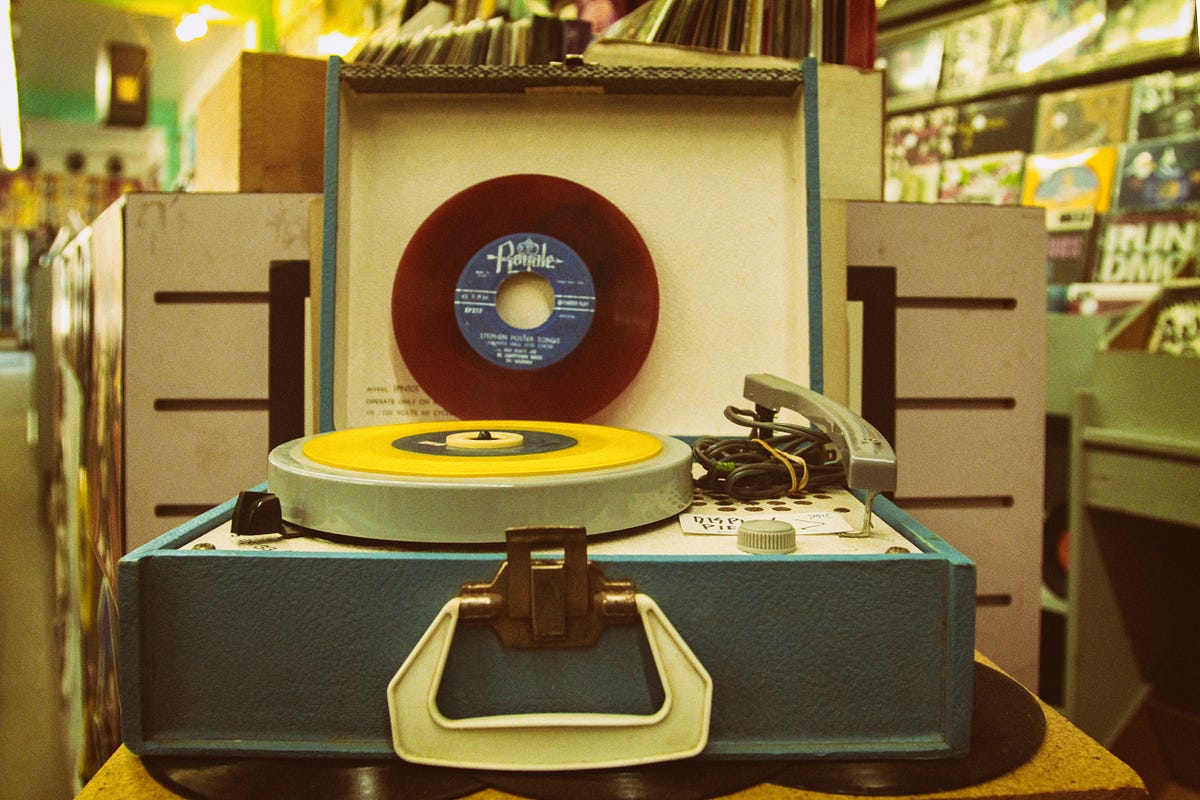I remember: Music Delivery Technology
Very Early Radios had Vacuum Tubes

Radio
I remember the early Tube Radios which were rather large pieces of furniture. Over time, with the invention of the transistor it reduced them to a smaller footprint and even table top devices. And later hand held battery operated music dispensers, and we became Disc Jockeys for the moment.
By the time I was driving a car it came as standard equipped.

Vinyl
Vinyl records allow people to listen to music without that talk from disc jockeys and the commercial ads we heard but did not want to listen to.
78 RPM records were still around in my early childhood but 45s and 33 1/3 vinyl albums were what I remember from the beginning. With my childhood job’s earning, records where and item I would purchase among others.
The 78 and 33 1/3 vinyls both had the same size hole in the center to place the record on a spinal, and the 45 had a large hole. To play the 45 vinyls you had to place a sleeve over the smaller post and snap in into place before placing the record on it. The record player had a setting to go from 78 to 33 1/3 to 45 RPM to get the right speed otherwise the music sounded like the chip monks singing.
In the 60s and 70s there were many genres but for me the rock-and-roll years was the music I listened to most, and some blues.
Record players required you to be in one place, and not driving around, walking, running, but stationary.
Portability — Music on the run
Tape players, CD players, personal audio players, boomboxes all allowed portability and mobility. With the portable playing devices you could now take it with you, move it around from place to place. One of the most important aspect of portable music was a choice. You could now play what we wanted, and latter technology allowed us to skipping a song, with the next option, if that’s what we wanted.
Tape Players
Tape players allowed us to take our music from place to place and use in different devices, ours, our friends, and others.
Tape players had three different versions over time:
Soon after the 4 track tape the 8-track tapes and players they added portability to creating your own music selections and with no commercials like vinyl’s provides previously. Both 4 track and 8 Track contained the same music available on vinyl records. 8 track allow more music on less tape.
I installed a 4 track tape player in my car, under the glove box, and later in the glove box. Someone broke my passenger window and stolen my 4 track when it mounted under the glove box, it survived when mounted in the glove box.
Cassette Player
Cassette players further reduced the footprint of the 4 and 8 track to a smaller and much more portable size. With the further advancements in the technology we could record our own cassettes from our vinyl records.
Cassettes were small enough that cassette players and radios soon were one unit for your car. We soon were replacing our factory car radios with a Radio/Cassette player in dash.
Compact Disc players
The next leap in technology was that music was available on CD or compact Disc. This meant that more music was available on a ridged almost indestructible medium. Like cassette early version were commercially available, but later like cassettes, one could create your own lineup of music
Personal Audio Players
Transistor Radios and boomboxes provided additional elements of portability. Radio was available at the beach, or where ever you were and as long as you had batteries. Boomboxes allow portability of not only radio but cassette and CD media.
Subscription Services
Subscription services allowed us to avoid the commercials, announcer’s opinions and jokes.
Satellite Radio
But still someone else was programming what we heard.
XM Radio and Siris Radio were which required the purchase of special equipment manufactured for the respective services.
I purchase an early portable XM Radio which I could play in my car, with headsets, and take it with me when I was traveling and in rental cars.
On July 29, 2008 XM Radio and Sirius Radio completed a merge and became Sirius XM Satellite Radio Inc
Music on MP3 players
MP3 players were another step where you had control of the music and order of the playlist.
You purchased the rights to use the music either by song or album. You could build your own play lists. You could have many playlist with the same song in a multiply play list.
Music Services to devices
Music next became available on any computer, tablets, smartphone, smart TV and other portable players.
Companies music as a subscription service, most with no commercials, and some for a lesser fee with limited commercials, for example Pandora, Spotify, iTunes, Amazon Music, Napster, YouTube, the list is long, look at Wikipedia for a full list.
Sirius XM Satellite Radio purchased Pandora Radio in February 2019 and they still operate the Pandora Radio brand as a standalone brand.
Some streaming services have merged and other no longer exist over the years.
Bluetooth listening devices
Bluetooth wireless technology allowed us to extend the possibility of different listening devices which wire connected wirelessly. Speaker, headset or buds, and other options were not available to listen to our music.
You could connect your computer, tablet, smartphone to other Bluetooth devices. Speakers, headsets, cars, place a device in the cigarette liter, transmitted via Bluetooth and hear on an unused radio frequency.
Smart TV Apps
Smart TVs added another element of receiving our music via built in apps and other devices we could connect to our smart TV via HDMI ports. Connected existing players or other self-contained application devices like
What is next or is already on the horizon? Virtual Reality Music Concerts?
Sign up for my newsletter containing my stories and thoughts delivered weekly
Originally published at www.rogerskibowski.com.
